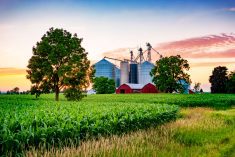It s a bedrock of car advertising. Maybethebedrock. If an ad is going to sell cars, it has got to show sheet metal. A lot of sheet metal. Not surprisingly, this has
also been the bedrock of farm machinery marketing too. A flip through any farm magazine will prove it.
Now, Case IH s new ads are putting its tractors in the background. Even the headlines don t really focus on the machines.
Instead, the ads are about the fact that the world will have 1.2 billion more mouths to feed by the end of the next decade, and about the fact that farmers must increase food production by 50 per cent by 2050.
Read Also

What to consider when setting up farm-related business ventures
N/A
Will you be ready? the ads ask. There s another question that the industry
By Scott Garvey, CG Machinery Editor
is asking. Will these ads make you take a harder look at Case IH tractors? We believe so, says Duane Nelson, director of global branding and marketing for the company. But Nelson s confidence may be because he is expecting his ads to do something different than you re expecting.
Nelson doesn t want the ads to make you think that a specific Case IH tractor is a better buy than a specific competitor, at least not at this point. Instead, he wants you to prefer the idea of the Case IH brand, because he thinks such brand preference will drive you to his dealerships.
So, are you the kind of buyer who will be influenced? It seems to run counter to the no-nonsense, unemotional image that farmers have of themselves.
It isn t as if Case IH had no choice but to go to a soft focus because it doesn t have any new products to talk about. If anything, the opposite is true. 2010 has been a landmark year for Case IH. On the engineering front, the company launched its redesigned Magnum and Steiger tractor lines, which were three years in development. It also announced, along with sister company New Holland, that it will become the next agricultural equipment manufacturer to adopt selective catalytic reduction technology to meet Interim Tier 4 engine emissions standards.
In conjunction with those announcements, the company has kicked off one of the most extensive advertising campaigns in its history. In fact, it represents an incredible ten-fold increase in spending over previous initiatives.
Walking through Case IH s Burr Ridge, Illinois, research and development facility last June, it was hard not to notice both Case IH and New Holland product posters hanging on the walls throughout the engineering offices. In speaking to the staff, it s clear both red and blue engineers are sharing technology on at least a few projects.
So, you might wonder if the distinctive new tractors and the bold advertising campaign are part of a strategy to open up some distance between the two companies and differentiate Case IH from New Holland in the marketplace.
Not so, according to Nelson. The company doesn t consider New Holland to be a rival, he says. They are not a competitor of ours. Our efforts are focused solely on differentiating Case IH from competitive brands.
So the goal was to find a way to differentiate Case IH from the other manufacturers, and to do it in a way that could cut through all the noise of all the other messages directed at farmers.
Our analysis of the global competitive landscape revealed every other equipment manufacturer was focused entirely on the equipment itself, Nelson says. We concluded a campaign which focused on the needs of the producer first met all the criteria for a strong brand campaign.
Having said that, we also knew we couldn t ignore the need producers have for product information. Therefore, we developed the campaign to utilize complementary strategies, which when used together will present both the demands on agriculture and how equipment from Case IH will prepare producers to meet those demands.
Here s how Nelson thinks the ads will work on you. Half of the campaign strategy is to present either an issue or an opportunity facing agriculture such as the growing global population or the decline in available farmland and ask, Will you be ready?
The second strategy is then to come in on top of these messages and say that equipment from Case IH that will prepare farmers to be ready to tackle the future.
By focusing on an issue first and the machines second, the campaign is similar to the new advertising style adopted by a few automakers, like Volkswagen, who have also broken away from the show-sheet-metal school of thinking. A look at MOTOR TREND magazine s top 10 online ads showcases the growing trend. Instead of showing cars driving along scenic mountain roads, some ads only show people having fun in a unique way. Remarkably, one video does not show any vehicles at all.
Still, when it comes to the traditional advertising practices common in the farm machinery marketplace, Case IH s move is a bold one, and it may be timely. The Food and Agriculture Organization of the United Nations has been one of the voices recently expressing the need for a new Green Revolution in order to meet future demand for food, which just happens to mirror the focus of Case IH s initial wave of ads.
The first green revolution occurred in the early 1960s, when improved mechanization was essential to reaping the benefits of new plant genetics. The idea was a boon to farm equipment manufacturers then. Can it be again?
To get the higher yields that we re going to need to feed the world in coming years, farm attention has mainly focused on improved agronomic practices and the development of new higher-yielding and drought tolerant crops, not better equipment. But with the improvement in yields over the past few decades, farmers even today experience trouble using some machinery built a generation ago.
Nelson believes demands on machinery will continue to rise, and he thinks that by asking such questions, Case IH is showing it s on the leading edge.
Advances in mechanization must go hand-in-hand with seed, fertilizer and pesticide improvements, Nelson says. One is not greater than the other.
When Case IH introduced the new Steiger and Magnum tractors to the media in June, management emphasized the importance of input from a panel of producers brought in early in the design and development process. According to Nelson, producer input was also part of the process of determining the theme of the Will You Be Ready ad campaign.
This campaign is not the result of an internal brainstorming session, he says. It is based on tens of lengthy qualitative interviews conducted with producers on three continents. The initial results are very compelling. Producers have provided unsolicited feedback. The campaign resonates with them.
Establishing and maintaining an even broader-based dialogue with producers is also a key element in the advertising. As the campaign matures, the company will provide an online site for public discussion of the need to be ready. The web-site www.caseih/ beready.com already has links to discussion papers on the world demand for food.
The overall plan, according to a corporate press release, is to establish the company as the brand of choice for today s professional producers. In that release Nelson has this quote attributed to him: We don t make backyard mowers just tractors, combines and other agricultural equipment for professional producers.
But does that mean the company will drop products like compact and utility tractors?
Case IH makes farm equipment for all producers, Nelson answers. Regardless of your operation s size whether you have a small dairy farm in Wisconsin or run a large wheat operation in Manitoba Case IH makes agricultural equipment for all professional producers.
The global demands being placed on the industry today are not exclusive to just one type of operation, Nelson says. He says Case IH will support all producers and will continue to make the equipment that is most appropriate for any size operation.
In the end, Nelson sums up the initiative and hints at things to come this way: This campaign won t leave a doubt in anyone s mind that Case IH is the equipment maker that puts farmers first. CG
———
When You Put The Tractors In The Background,Says Nelson, You Can Put The Farmer Up Front.But Is That Enough To Make You Buy?














